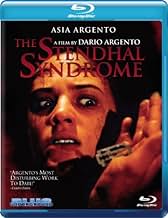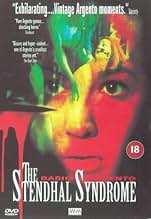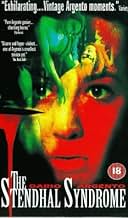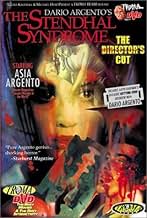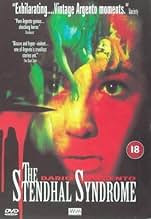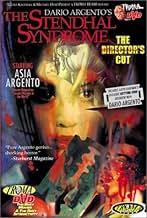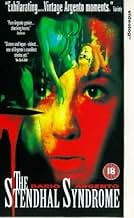AVALIAÇÃO DA IMDb
6,0/10
9,6 mil
SUA AVALIAÇÃO
Uma jovem mulher policial vai lentamente enlouquecendo enquanto segue um esquivo estuprador e assassino em série pela Itália.Uma jovem mulher policial vai lentamente enlouquecendo enquanto segue um esquivo estuprador e assassino em série pela Itália.Uma jovem mulher policial vai lentamente enlouquecendo enquanto segue um esquivo estuprador e assassino em série pela Itália.
- Direção
- Roteiristas
- Artistas
- Prêmios
- 1 vitória e 6 indicações no total
Avaliações em destaque
Argento's main concern as a filmmaker is always with the camera, because for him, the camera is not only something that is used to record the action, but is a constant representation of the eye. This notion is even more important than ever before with The Stendhal Syndrome (1996), Argento's bizarre and brutal thriller, in which an inexplicable affliction pertaining to the relationship between art and the viewer is used as a springboard to a peculiar concoction of murder, rape, identity crisis and pure, psycho-sexual dread.
The story is typical of Argento, with some wonderful references to the classic Giallo style of storytelling found in his earlier films, such as The Bird with the Crystal Plumage (1970), Four Flies on Grey Velvet (1971) and Deep Red (1975), with the continual juxtaposition between the initial police investigation and elements of amateur sleuthing, and all within the broader "stalk and slash" universe of masked killers, wandering point-of-view shots and black leather gloves. However, this is in direct contrast with the incredible viciousness presented by Argento and directed primarily at the central character, in this instance, the young female police investigator, Anna Manni. The treatment of the violence and, in particular, the sexual violence, goes way beyond the brutality of even Tenebrae (1982) or Opera (1988), as the filmmaker attempts to invade a limited psychological space - both in terms of the story and in the visual presentation - that is much deeper and more sinister than anything Argento had done before or since.
The plot here is broken up into two very distinct halves; with the first half showing our protagonist in pursuit of a vicious serial killer who uses her affliction to ensnare her, and the second half showing the breakdown in Anna's personality following a prolonged and violent encounter with the murderer himself. The two different strands are handled well by Argento, with the first half showing his revived interest in the conventions of the Giallo and the second half demonstrating his interest in psychological issues familiar from the masterwork Tenebrae and the largely forgettable American-set thriller Trauma (1993).
There's also a greater attempt to create something approaching reality here, with none of the vivid colours of films like Suspria (1977) and Inferno (1980) or the bravura camera movements or elements of fragmented shot-construction found in Tenebrae and Deep Red. The film points the way forward to subsequent projects, Sleepless (2000) and The Card Player (2005), the latter of the two being something of a thematic sequel to the film in question (though really, this idea makes little to no sense when considered within the context of this film's climax). As bold and different as this presentation is, it must be said that the switch in style isn't entirely successful. There are still a number of slight flaws to the film that we will come back to, but really, it is the occasional drop in quality or the seemingly unbelievable elements of the plot that jar somewhat against the two very distinct and different worlds that the director is trying to create. This still doesn't stop the film from being the best thing that Argento directed in the 90's, and his most enjoyable film overall since Opera almost ten years before.
For me, Sleepless is still the best thing he's directed in the last twenty years, but The Stendhal Syndrome has plenty going for it, even if the abstract concept at the heart of the film may be too outlandish for many to accept. Although there are plot holes and the usual poor dubbing/listless performances, the film makes some valid points about the relationship between art and those that view it, and the always fascinating notions of sight and perception (the things we see and things we feel). Not a masterpiece for certain, but one that regardless offers an interesting idea and some truly thrilling moments of terror and dread.
The story is typical of Argento, with some wonderful references to the classic Giallo style of storytelling found in his earlier films, such as The Bird with the Crystal Plumage (1970), Four Flies on Grey Velvet (1971) and Deep Red (1975), with the continual juxtaposition between the initial police investigation and elements of amateur sleuthing, and all within the broader "stalk and slash" universe of masked killers, wandering point-of-view shots and black leather gloves. However, this is in direct contrast with the incredible viciousness presented by Argento and directed primarily at the central character, in this instance, the young female police investigator, Anna Manni. The treatment of the violence and, in particular, the sexual violence, goes way beyond the brutality of even Tenebrae (1982) or Opera (1988), as the filmmaker attempts to invade a limited psychological space - both in terms of the story and in the visual presentation - that is much deeper and more sinister than anything Argento had done before or since.
The plot here is broken up into two very distinct halves; with the first half showing our protagonist in pursuit of a vicious serial killer who uses her affliction to ensnare her, and the second half showing the breakdown in Anna's personality following a prolonged and violent encounter with the murderer himself. The two different strands are handled well by Argento, with the first half showing his revived interest in the conventions of the Giallo and the second half demonstrating his interest in psychological issues familiar from the masterwork Tenebrae and the largely forgettable American-set thriller Trauma (1993).
There's also a greater attempt to create something approaching reality here, with none of the vivid colours of films like Suspria (1977) and Inferno (1980) or the bravura camera movements or elements of fragmented shot-construction found in Tenebrae and Deep Red. The film points the way forward to subsequent projects, Sleepless (2000) and The Card Player (2005), the latter of the two being something of a thematic sequel to the film in question (though really, this idea makes little to no sense when considered within the context of this film's climax). As bold and different as this presentation is, it must be said that the switch in style isn't entirely successful. There are still a number of slight flaws to the film that we will come back to, but really, it is the occasional drop in quality or the seemingly unbelievable elements of the plot that jar somewhat against the two very distinct and different worlds that the director is trying to create. This still doesn't stop the film from being the best thing that Argento directed in the 90's, and his most enjoyable film overall since Opera almost ten years before.
For me, Sleepless is still the best thing he's directed in the last twenty years, but The Stendhal Syndrome has plenty going for it, even if the abstract concept at the heart of the film may be too outlandish for many to accept. Although there are plot holes and the usual poor dubbing/listless performances, the film makes some valid points about the relationship between art and those that view it, and the always fascinating notions of sight and perception (the things we see and things we feel). Not a masterpiece for certain, but one that regardless offers an interesting idea and some truly thrilling moments of terror and dread.
I don't really understand why so many Argento fans dislike this film, I think it's one of his best works. It's not always easy to watch, it has some very nasty violence, even for an Argento film, I wouldn't recommend the film to sensitive persons; but it's not for exploitational purposes. Argento does a good job of juggling real-life horrors with a dreamy, hallucinatory atmosphere, and pulls off some typically Argento-esque setpieces, such as the one in which a bullet is followed through a woman's mouth with the aid of CGI. The great Ennio Morricone delivers possibly his best score for a horror film, the haunting main theme with his trademark wordless female vocals stayed with me long after the film was over. Frequent Fellini cameraman Giuseppe Rotunno does an excellent job on the film too.
The Stendhal Syndrome isn't for everyone, but it's worth a viewing for fans of European horror and psychological thrillers in general.
The Stendhal Syndrome isn't for everyone, but it's worth a viewing for fans of European horror and psychological thrillers in general.
La Syndrome di Stendahl has met cruel critical comments on its initial release but although it is not at all like his earlier work, it is in fact a far more intelligent and mature affair. Anna Manni, the character played by Asia Argento, has more compassion than any other character in an Argento film, quite unlike the carelessly created cartoon-like characters of his other work. It is true, however that the film drags slightly in the middle, although picks up the pace again for a surprising and beautifully directed finale; and although the film is not as bloody as tenebrae, the violence on display is brutal and sexual (leading to it being cut for release in Britain) and genuinely disturbing. Perhaps not as good as Deep Red or Suspiria, but definitely one of this unusual director's better efforts.
Dario Argento is one of my all-time favorite directors, and probably THE living director I admire the most. The 1990s were a weak decade for Horror in general, and also Argento's weakest. Argento is a cinematic genius, however, and while 90s achievements get nowhere near the brilliance of his masterpieces from the 70s and 80s, films like "Trauma" (1993) or this "Stendhal Syndrome" are nonetheless more than decent Thrillers that outshine the majority of 90s Horror outings.
"La Sindrome Di Stendhal" aka "The Stendhal Syndrome", which was made in-between "Trauma" and the disappointing "Il Fantasma Dell'Opera" (1998), is certainly one of his lesser films, but definitely a more than decent, very suspenseful, atmospheric and often quite weird psychological Horror effort that his fans cannot afford to miss. I like it about equally as I do "Trauma", with a slight preference for "The Stendhal Syndrome" due to the brilliant score by Ennio Morricone. What I found a bit strange is that the film is often labeled as a Giallo, when it is not really. There are no stylishly bloody murders from the killer's perspective, and really what makes the term "Giallo" quite out of place is the fact that the killer's identity is not really a mystery. The suspense is there, however, and most true Horror fans will agree that Argento is the absolute master of suspense. While the film is not quite as exceptionally gory as many other Argento flicks, it is definitely violent, especially the several rape-scenes (one of them taking place quite in the beginning) are more than a bit brutal.
Argento reportedly first wanted to get Bridget Fonda and Jenifer Jason Leigh for the leading role in the film, but his beautiful daughter Asia Argento is, as far as I am considered, the perfect cast for the role. She may look a little too young for an experienced female homicide detective, but she fits the character of her role perfectly, and, as far as I am considered, that is most important. Asia plays detective Anna Manni, a Rome investigator specialized on sex crimes, who is trying to track down a serial rapist and murderer... I do not want to give any more of the plot away. The rest of the performances are also quite good, especially the German actor Thomas Kretschmann delivers a good performance, but Asia Argento sure is the highlight. The film is quite different to Argento's other films, but certainly not bad. None other than the great Ennio Morricone delivers a brilliant and immensely eerie score that intensifies the creepy atmosphere, and, as it is always the case with Argento's films, the film is visually stunning and highly suspenseful.
Dario Argento's masterpieces are his films from the 70s and 80s, and he returned to old greatness in 2001, with the ultra-violent and greatly old-fashioned Neo-Giallo "Non Ho Sonno" (aka. "Sleepless"), which was made in brilliant Argento-tradition. His 90s outings are certainly a bit inferior to the rest of his brilliant repertoire, but they are nonetheless way above average. While it is one of lesser films, "The Stendhal Sydrome" is nevertheless a suspenseful, atmospheric and highly recommendable film with some downright ingenious elements that Horror lovers should definitely not miss. Highly recommended!
"La Sindrome Di Stendhal" aka "The Stendhal Syndrome", which was made in-between "Trauma" and the disappointing "Il Fantasma Dell'Opera" (1998), is certainly one of his lesser films, but definitely a more than decent, very suspenseful, atmospheric and often quite weird psychological Horror effort that his fans cannot afford to miss. I like it about equally as I do "Trauma", with a slight preference for "The Stendhal Syndrome" due to the brilliant score by Ennio Morricone. What I found a bit strange is that the film is often labeled as a Giallo, when it is not really. There are no stylishly bloody murders from the killer's perspective, and really what makes the term "Giallo" quite out of place is the fact that the killer's identity is not really a mystery. The suspense is there, however, and most true Horror fans will agree that Argento is the absolute master of suspense. While the film is not quite as exceptionally gory as many other Argento flicks, it is definitely violent, especially the several rape-scenes (one of them taking place quite in the beginning) are more than a bit brutal.
Argento reportedly first wanted to get Bridget Fonda and Jenifer Jason Leigh for the leading role in the film, but his beautiful daughter Asia Argento is, as far as I am considered, the perfect cast for the role. She may look a little too young for an experienced female homicide detective, but she fits the character of her role perfectly, and, as far as I am considered, that is most important. Asia plays detective Anna Manni, a Rome investigator specialized on sex crimes, who is trying to track down a serial rapist and murderer... I do not want to give any more of the plot away. The rest of the performances are also quite good, especially the German actor Thomas Kretschmann delivers a good performance, but Asia Argento sure is the highlight. The film is quite different to Argento's other films, but certainly not bad. None other than the great Ennio Morricone delivers a brilliant and immensely eerie score that intensifies the creepy atmosphere, and, as it is always the case with Argento's films, the film is visually stunning and highly suspenseful.
Dario Argento's masterpieces are his films from the 70s and 80s, and he returned to old greatness in 2001, with the ultra-violent and greatly old-fashioned Neo-Giallo "Non Ho Sonno" (aka. "Sleepless"), which was made in brilliant Argento-tradition. His 90s outings are certainly a bit inferior to the rest of his brilliant repertoire, but they are nonetheless way above average. While it is one of lesser films, "The Stendhal Sydrome" is nevertheless a suspenseful, atmospheric and highly recommendable film with some downright ingenious elements that Horror lovers should definitely not miss. Highly recommended!
Argento had seen his better days as a movie director and surely it's not easy to top such masterpieces such as Suspiria and The Inferno.
Asia Argento as detective Anna Manni isn't the best casting choice but as an actress she certainly did her best. It's difficult to believe that she really is a police detective at such a young age. It's obvious that a more mature actress should have been cast. Nevertheless that obscurity could have been used to make the film better. Would it be a better film if Anna Manni was just a woman living in her delusions.
The film certainly had it's moments but on the other hand it has some annoying flaws such as very bad cgi effects. Why use experimental effects if they look dumb. They should have gone back in time to the 70's or 80's how they made the effects without computers.
Ennio Morricone's score is amazing though and certainly does a big favor for the film's atmosphere. To sum it up this film is watchable even for Argento fans but it isn't anything like his films used to be. It's really evident that Italian film industry had been in a recession since the late 80's.
Asia Argento as detective Anna Manni isn't the best casting choice but as an actress she certainly did her best. It's difficult to believe that she really is a police detective at such a young age. It's obvious that a more mature actress should have been cast. Nevertheless that obscurity could have been used to make the film better. Would it be a better film if Anna Manni was just a woman living in her delusions.
The film certainly had it's moments but on the other hand it has some annoying flaws such as very bad cgi effects. Why use experimental effects if they look dumb. They should have gone back in time to the 70's or 80's how they made the effects without computers.
Ennio Morricone's score is amazing though and certainly does a big favor for the film's atmosphere. To sum it up this film is watchable even for Argento fans but it isn't anything like his films used to be. It's really evident that Italian film industry had been in a recession since the late 80's.
Você sabia?
- CuriosidadesThe opening scene was shot inside the famous Uffizi Gallery in Florence. As of 2014, Dario Argento is the only director who's ever received permission to film inside the museum.
- Erros de gravaçãoThough featuring prominently during the film's opening sequence set at the Uffizi in Florecne, Peter Bruegel's 'Landscape with the Fall of Icarus' is actually housed at the Royal Museum of Fine Arts of Belgium in Brussels.
- Citações
Insp. Manetti: You're young. I can trust you.
- Versões alternativasUS DVD release by Troma release is the complete version of the English language edition, but, like all English releases, is still missing around 2 minutes of material exclusive to the Italian print.
- ConexõesFeatured in Il mondo di Dario Argento 3: Il museo degli orrori di Dario Argento (1997)
Principais escolhas
Faça login para avaliar e ver a lista de recomendações personalizadas
- How long is The Stendhal Syndrome?Fornecido pela Alexa
- What are the differences between the Original Version and the Extended Version?
Detalhes
Bilheteria
- Orçamento
- US$ 3.800.000 (estimativa)
- Tempo de duração2 horas
- Cor
- Mixagem de som
- Proporção
- 1.85 : 1
Contribua para esta página
Sugerir uma alteração ou adicionar conteúdo ausente

Principal brecha
By what name was Síndrome Mortal (1996) officially released in India in English?
Responda


